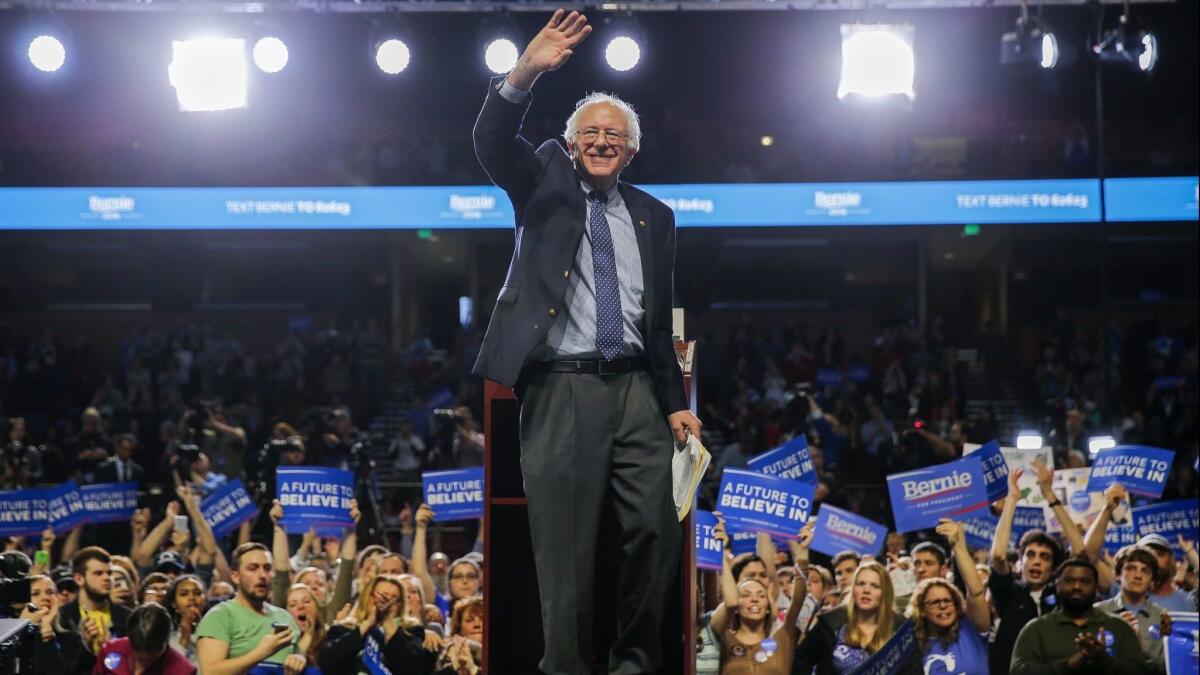Op-Ed: ‘Medicare for all’ is popular, but it’s likely doomed to fail

When people have health issues — be it back pain or obesity — they hope for a painless, effortless solution. We all want that magic pill, and not just for our medical problems.
Our nation’s desire for pain-free solutions has turned “Medicare for all” into the most popular brand in healthcare policy. Americans, tired of high deductibles and outrageous drug prices, now strongly support the idea of a government-run universal health plan, aka single-payer insurance.
When you look at the success of Medicare today, it’s easy to see the appeal.
Traditional Medicare, fee-for-service insurance for Americans 65 and older, lets enrollees visit almost any doctor or hospital without paying much out of pocket. And for seniors who prefer an HMO or PPO model with more coordinated care and added benefits, there’s Medicare Advantage, which has seen enrollment double since 2010. Both options, regardless of one’s preexisting conditions or annual income, offer generous coverage in exchange for modest annual fees and small co-payments.
Government-run programs work well in the rest of the world because the cost of medical care delivery is considerably less than in the United States.
It’s no wonder Gallup’s findings show that seniors enrolled in Medicare are the nation’s most satisfied patients. But would this same program, rolled out to every citizen, be the painless magic pill Americans believe it to be?
Unfortunately, no. As with any medication, there are side effects, which in this case can include higher taxes, skimpier benefits and delays in care. The exact complications depend on the specific government program implemented. There’s more than one way to design and fund Medicare for all.
America’s first legislative attempt at a single-payer system was the Expanded and Improved Medicare for All Act of 2003. This rough, 30-page outline of benefits offered little detail on how to fund the multitrillion-dollar package.
More recently, Sen. Bernie Sanders (I-Vt.) backed the Medicare for All Act of 2017. His proposal called for generous benefits that would have put an end to employer-sponsored insurance. It too contained little information on funding.
And when the California Legislature put forth Senate Bill 562 in 2017, the proposal never left committee. That’s partly because the annual cost of implementation was estimated at $400 billion, double the state’s budget. Even newly elected Gov. Gavin Newsom has walked back his campaign pledge of Medicare for all, favoring a more incremental approach to funding health coverage for California’s 22 million citizens.
That’s the thing about Medicare for all: When details are scarce, the plan is popular. But the more people learn, the less appealing the idea becomes. Recent polls show net favorability of single-payer programs plummets when people hear what economic sacrifices are necessary to make the numbers work. For voters, eliminating private insurance, hiking taxes and slashing the benefits of today’s Medicare program — all of which to various degrees would be required in any Medicare for all plan — are non-starters.
Looking at the numbers behind current Medicare explains why such sacrifices will be necessary.
Through the Centers for Medicare and Medicaid Services, the federal government dictates how much it pays doctors and hospitals. Providers estimate that Medicare currently reimburses only 90% of the total cost for its beneficiaries. This puts the onus on the rest of us — primarily U.S. businesses and their employees — to make up the difference. Employers pay about 120% of the cost to care for the 155 million Americans they insure, with the extra going to cover what Medicare doesn’t (and the uninsured). Increasingly, though, businesses are passing much of the added expenses on to employees through higher deductibles and lower wages.
To address the economic imbalance of turning Medicare into the much more ambitious Medicare for all, the U.S. government has three options, each painful.
The program could pay 100% of the costs for providing care, rather than 90%. Doing so would require the federal government to find an additional $3 trillion over the next decade, likely through higher taxes.
Alternatively, the government could fund the gap by reducing what the universal insurance covers or raising fees for all participants, even for those already on Medicare.
Option 3: Medicare for all could continue paying providers 90%. But doctors and hospitals would offset lost revenue by giving preferential treatment to patients who buy supplemental private insurance. Patients who don’t would get pushed to the back of the line, which is what happens in most countries with government-funded healthcare.
What about other options to expand coverage? Any magic pills among them?
State governments could expand coverage through “Medicaid for all.” For today’s uninsured, it’d be better than nothing, but California’s version of it (Medi-Cal) pays providers so little that emergency room wait times have doubled in many locations.
Enter the Fray: First takes on the news of the minute »
The numbers don’t add up for a patchwork “Medicare for some” plan either, which would cover patients 55 to 65 years old ( and anyone else wishing to opt in). This plan would produce the same side effects — higher taxes and benefit reductions — on a slightly smaller scale.
All universal coverage plans, be they Medicare for all or the Affordable Care Act, fail when the costs for delivering the care exceed the nation’s ability to pay.
America’s fascination with Medicare for all is born of good intentions. Americans are hurting and in search of relief. Nearly 30% of U.S. adults struggle to pay their medical bills, and more than 20% say they’ve put off treatment or filling a prescription because of cost.
Unfortunately, in our search for a magic pill, we’ve missed the key point. Government-run programs work well in the rest of the world because the cost of medical care delivery — what doctors, nurses and drug companies get paid — is considerably less than in the United States. Lowering the cost of care would mean reining in drug prices, eliminating unnecessary procedures, and closing small, inefficient hospitals. Until we do, every approach, including Medicare for all, will fail. There is no painless solution, no magic pill.
Dr. Robert Pearl was chief executive of the Permanente Medical Group — the doctors who provide care for those covered by the Kaiser Permanente health plan — for 18 years. He is the author of “Mistreated: Why We Think We’re Getting Good Healthcare — and Why We’re Usually Wrong.” He hosts the podcast “Fixing Healthcare.”
Follow the Opinion section on Twitter @latimesopinionand Facebook
More to Read
A cure for the common opinion
Get thought-provoking perspectives with our weekly newsletter.
You may occasionally receive promotional content from the Los Angeles Times.






